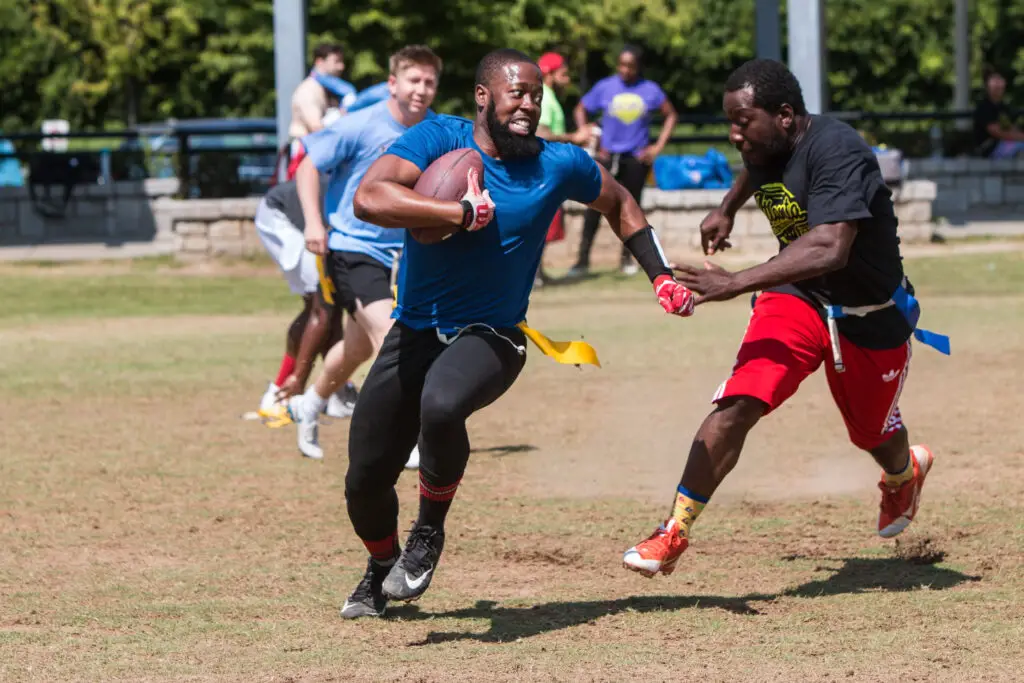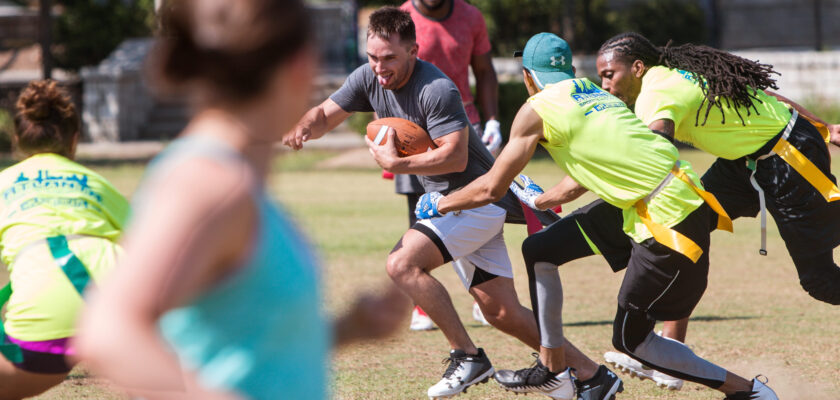American soccer is extremely popular in the USA and in many parts of the world, and is also gaining increasing interest in Brazil. The NFL is a robust, competitive league that generates billions in revenue through sponsorship, broadcasting rights and ticket sales, and this sport attracts many amateur athletes. But is it possible to play American soccer without the typical equipment of a professional game? Yes! Learn all about Flag Football.
Open your Betano account and get up to 1,000 reais in bonuses.
Payments via PIX, live games and super odds!
Click here to open your account!

Read to the end to find out all about flag football!
All about Flag Football: what is it?
Flag soccer, a version of American soccer or gridiron, has never featured in previous editions of the Olympic Games;
This sport was presented as a demonstration sport at the 2022 World Games in Birmingham, Alabama, where the United States won the gold medal in the men’s category and Mexico beat the hosts in the women’s final.
Similar to American soccer, the aim of flag soccer is to progress down the field using a sequence of offensive plays until you reach the opposing team’s defensive end zone.
This is a non-contact sport, and tackles are made by removing one of the three “flags” – which are more like strips of fabric – attached to the waist of the player with the ball, one on each side and one on the back.
Read on to find out all about flag football!
All about Flag Football: history
According to US documents, the less aggressive version of American footballwas created during the Second World War;
The soldiers developed this game with less risk of injury as a form of entertainment and to distract themselves during their free time during the war;
After being officially introduced in the country, flag football began to attract players of all ages.
The need for a safer game, especially for children and teenagers, led to the creation of the first flag football rules, which eliminated direct physical contact;
Instead of tackles with contact, players were tackled by removing one of the flags or sashes attached to their waist, which significantly reduced the risk of injury.
The rules of flag football began to be formalized in the 1940s and 1950s. Specifically, in the 1940s, adjustments were made to make the game more organized and safer, especially in school and community environments;
This included defining the rules on how flags should be used and how plays should be conducted.
Read to the end to find out all about flag football!
In the following years, flag soccer gained popularity at various levels, especially in schools and universities, where it was seen as a way of allowing American soccer to be practiced without the risks associated with intense physical contact.
The sport began to be played in recreational clubs and youth organizations, and its rules were refined to promote inclusion and accessibility.
Recently, flag football has spread beyond the United States, being adopted in various parts of the world.
Its less intense nature and accessibility have attracted players of all ages, contributing to its growth as a competitive and recreational sport globally.
Today, flag football is recognized as a dynamic and inclusive sport that maintains the spirit of American soccer while providing a safer and more accessible experience for all participants.
Read to the end to find out all about flag football!
All about Flag Football: how does a match work?
Plays and objectives
The game starts at the five-yard line, where the center passes the ball to the quarterback, who then tries to find a receiver for a forward pass or hands the ball off to a runner.
Play is completed when a flag is removed, the ball carrier moves out of bounds or a forward pass touches the ground.
Each team has four attempts, called downs, to advance to the midfield line. If they succeed, they will have four more downs to reach the end zone and score a touchdown.If they don’t succeed in any attempt, possession of the ball is transferred to the opponent, who will start on their own five-yard line.
Read to the end to find out all about flag football!
Turnovers
Turnovers can also occur through interceptions, when a defender catches a ball intended for a receiver, and fumbles, when the ball carrier drops the ball and a defender recovers it.
In flag football, no plays are allowed when the offensive team is five yards or less from the end zone.
Score
After scoring a touchdown, which awards six points, teams can choose to attempt an extra point – by running or passing, but not kicking – from the five-yard line, or to attempt two extra points from the 10-yard line.
Lawn dimensions
A flag football pitch has dimensions of 70×30 yards (64m x 27.4m), with 10 yards (9.1m) dedicated to each of the two end zones.
Read to the end to find out all about flag football!
Departure time
The match is divided into two 20-minute periods, with the clock running continuously during each period until the two-minute signal.
After the two-minute signal, the clock is stopped whenever a pause occurs, such as when the ball carrier goes out of bounds, a forward pass lands on the ground, or there is a turnover or a score.
If the score is tied after the 40 minutes of regulation, sudden-death overtime takes place, where the first team to score wins.
Interference
Actions that cause direct physical contact between players are not allowed, and physical or aggressive interference will be penalized.
Exchanges of ownership
If a team fails to make sufficient progress on its downs, possession of the ball is passed to the opposing team, which starts on the opponent’s five-yard line.
Penalties
Infractions usually result in a loss of downs or a loss of yards. Examples of common penalties include holding and offside.
How to advance in the field?
The team that has possession of the ball is called the “offensive team”, and their objective is to cross the field until they reach the opponent’s end zone to score a touchdown. Watch the animation below!
The offensive team begins its play at the 5-yard line and has 4 opportunities to reach the middle of the field;
If they succeed, they’ll get 4 more attempts to score a touchdown. These attempts do not accumulate; for example, if a team reaches the middle of the field on the first play, they will have the same 4 opportunities to reach the end zone.
How to stop the other team’s advance?
The defensive team needs to be constantly alert to prevent a player from the opposing team from receiving a pass or advancing with the ball;
To stop progress, any defender can simply remove one of the flags from the player with the ball;
When this happens, the play is considered over, the ball is placed by the referee where the flag was taken, and the offending team will have its next opportunity.
All about Flag Football: how is it played in Brazil?
Currently, several formats of flag football are active in Brazil.
In Rio de Janeiro, the sport is played on the sands of the beaches, where there is a version with four players on each side, known as Beach Flag.
On the pitch, the most popular version is Flag 5 x 5, involving five players from each team, played on areas comparable in size to a soccer field.
Brazil has men’s and women’s flag football teams, made up of players from various teams in different regions of the country.
Did you like learning all about flag football? Do you know any other Olympic sports?



